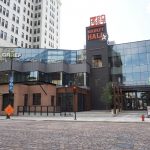Feature
Chicago Spire
Chicago Spire Originally uploaded by *Gary* I did quite a bit of reading on the Chicago Spire last night. As you may or may not be aware, the Spire is Santiago Calatrava‘s new building being built in Chicago that will be the tallest building in North America and the tallest all residential building in the world. What’s most impressive about the building, however, is the fact that it’s designed as a LEED Gold building. Sustainable features include recycled rainwater, river water used for cooling, ornithologically-sensitive glass to protect migratory birds, intelligent building and management systems, waste storage and recycling management, and monitored outdoor air delivery. Learn more. To think that at a building this big will achieve the highest certified sustainability measure is truly impressive. The only LEED Gold-certified building within the city of Milwaukee is the Johnson Control’s Brengel Technology Center.
Nov 5th, 2007 by Jeramey JanneneThe Residences on Water
The Residences on Water is beginning to rise out of the ground. The building utilizes a new development method, called the ER Post Structural System, that should allow for the pace of work to dramatically pickup in the coming weeks. This acceleration is possible because this method allows for all-weather erection, has fewer pieces and lets other trades begin work earlier in the process. The $20 million project is being developed by Fort Myers, FL based Development Opportunity Corporation. Once complete it will include a 128-room Staybridge Suites, 31 condo units, ranging in price from $234,000 to $2.3 million of which 8 have been sold so far, and 14,000 square feet of retail space. I believe this project will have long lasting positive impacts on the Water St district. First it finishes the corner by removing a surface parking lot which adds to the urban fabric. Secondly the new activity created by the residents and hotel guests will continue to fuel neighborhood business. Further this project is clearly connected to Manpower’s move to downtown and should support their business travel needs. Overall this is one of the most intriguing projects to watch considering the potential long term affects it will have on Water St.To follow this development I’ve started a flickr set, The Residences on Water, that I will update with new pictures to keep track of the progress. Articles Ready to rise Downtown Staybridge hotel, retail project to finally begin New Precast Building Product from Spancrete Speeds On-site Construction Time
Nov 3rd, 2007 by Dave ReidThe Catalyst
The Ghazi Company was all over the mainstream press this week with coverage of their updated plans for 4th & Wisconsin. Probably the biggest piece of news to come out of all these articles oddly is the project’s name, The Catalyst. Just like The Ghazi Company’s EpiCentre project in Uptown Charlotte, NC the name fits precisely. The potential impact of this project is catalytic due to its scale, the draw to the neighborhood of new residents and new customers, and its ability to raise the level of the neighborhood. Further it will be of value to the convention center by assisting in drawing bigger events as it adds new amenities and additional hotel rooms to the area. Missing from the news reports but also of note is that Afshin Ghazi, president of the The Ghazi Company, will be speaking at the 5th Annual Small Business Times Commercial Real Estate & Development Conference on November 8, 2007, where I’m sure we’ll hear more on The Catalyst project. Once this project gets under way I’ll be photographing their progress and posting them on flickr, but if you’d like to see what The Ghazi Company is doing in Charlotte, NC right now, take a look at their construction cam, my flickr set or Eric Bahr‘s photos. Articles Ambitious Downtown Construction Project Could Begin In Spring Project could get quick start Wisconsin Avenue hotel, retail project takes step forward
Nov 1st, 2007 by Dave ReidCity Hall Is Worth Every Penny
City Hall Originally uploaded by compujeramey Mike Nichols has an article in the Journal Sentinel lambasting politicians for their failings in properly estimating the cost of projects. Nichols gives me the feeling that he’s upset at Mayor Barrett for the expense of the City Hall and the coming need for a lift of the building (covered earlier on this site). Nichols acts as if City Hall is some giant sink hole that we as Milwaukeeans throw all our money into for no return and that is not an asset to Milwaukee anymore. He imposes upon me that his feeling is that we should have spent millions years ago to remove the wood pilings underneath and replace them with something else. As if the pilings that have lasted more than 100 years were a bad idea from the start, and that people should have known better. That politicians are continually draining Milwaukee of money to fix this building that’s fundamentally flawed. To paraphrase a recent Barrett quote I saw in the Shepherd Express ” it’s not like we’re putting hot tubs in”. Barrett is simply spending the money it takes to keep one of Milwaukee’s greatest landmarks operating and available for future generations. Nichols apparently disagrees with that idea.. It’s also a place some were already calling outmoded back in 1954, one that is now dwarfed by surrounding buildings and will continue to suck up money that could have been used on something new and inspiring.There’s at least the possibility that if taxpayers knew a few years ago what they were about to spend, they would have considered another, fully accessible, internationally admired Calatrava instead. We’ll never know because taxpayers have already made the leap that is now about to carry them all the way into the pilings under the basement. Only, I wouldn’t really call it a leap. It looks more like, without any real discussion at all, they were given a firm, silent, chicken-hearted push. If he’s so upset about City Hall and the money being spent, why doesn’t someone run for Mayor that is for a new City Hall? The simple reason is that a new City Hall would have the same cost overruns without the old world charm and history of the current building. The investment in City Hall is one that will preserve one of Milwaukee’s greatest landmarks. You can’t build 100+ year old buildings whenever you want. The building has stood the test of time and helps give downtown Milwaukee a distinct look and feel that is welcoming to visitors and respected by residents. City Hall doesn’t feature the glass casing like many new urban buildings or the massive parking garage that accompanies many of the large buildings in downtown Milwaukee. The building instead is a tribute to what Milwaukee has grown from, while pointing to the sky to demonstrate where Milwaukee is going to. As each new building rises around City Hall, the value of the distinct look of the building increases. It is […]
Oct 30th, 2007 by Jeramey JanneneSydney Hih Project Moves Forward
The controversial Sydney Hih project , that last summer was turned down for city financing of a TIF, appears to moving forward again. The first indications were the signing of multiple tenants to the project as recently reported in the Bizjournal article “Ruvin recruits Park East tenants”. The second significant step forward occurred this morning when the Public Works Committee approved a resolution agreeing to a long term lease with Ruvin Development Inc. of the city’s parking garage at 4th and Highland. This is important because Ruvin Development Inc.’s attempts to receive a TIF district revolved around the project’s perceived parking needs, so this agreement should allow Ruvin Development Inc. to move forward with the project. Additionally this will create a new revenue stream for the City of Milwaukee and better utilizes a city owned parking structure. I believe these two recent developments are very encouraging signs and that the Sydney Hih project may soon get underway. To follow this development I’ve started a flickr set, Sydney Hih that I will update with new pictures to keep track of the progress. Please note currently there’s just one photo as no construction has begun. Articles Ruvin recruits Park East tenants Plans on tap to rejuvenate Gipfel Brewery Billion-dollar building boom Gatehouse Capital and Ruvin Development select Kimpton for Milwaukee boutique hotel opening late 2009
Oct 30th, 2007 by Dave ReidThe End of the Beer Line
Marsupial Bridge Originally uploaded by repowers While the Beer Line railroad trunk has been gone from the Beer Line neighborhood for a long time, the last legitimate piece of the stretch has finally been given regulatory approval to close. With the closure of a 2.4 mile stretch by Wisconsin & Southern Railroad, all that is left of the famous line is 1 mile. In its heyday, the six-mile stretch hauled more freight than many cross-country railroads. It linked foundries, machine-tool shops, lumberyards, tanneries and makers of engines, castings, shoes, cardboard, cans, batteries, furniture and sausages. The north side line also connected three of the nation’s biggest breweries; during summer peaks in the 1950s, the Beer Line carried up to 270 boxcars each day with nothing but kegs and bottles. Read more… All things considered, you can’t be upset that the line is slowly being removed. The portion removed in the Beer Line neighborhood clearly has created a lot of land for quality development. I would expect the same to happen with the latest 2.4 mile stretch over time. Wisconsin & Southern clearly isn’t fleecing the city’s industries either, they’re simply not in need of large industrial shipping anymore. The only thing consistent in life is change. Apparently that rule applies to urban Milwaukee too.
Oct 29th, 2007 by Jeramey JanneneCity Hall is Sinking
City Hall Originally uploaded by compujeramey Bad news, while Milwaukee City Hall will certainly look good on the outside in due time, it’s going to be a little bit shorter because the building is sinking. In the past 20 years it’s dropped about one and a half inches, so it’s nothing drastic, but still something that will have to be addressed long-term. The 112-year-old building sits on 25,000 wooden pilings that stretch 27 feet downward into what used to be a swamp. The pilings are under water, which sounds bad but is actually how they’re preserved. Trouble started when some of the pilings dried out. Don’t try this with your basement, but the solution has been to pump more water under the building. Fixing it apparently would cost about $15 million, which is something whoever is in office will let slide as long as they can to avoid having the expense from repairing the building’s facade and leveling the building out lumped into one sum that is labeled as $100 million fleecing of Milwaukee taxpayers.
Oct 29th, 2007 by Jeramey JanneneThe 50 State Skyline
US Bank Building Originally uploaded by compujeramey If you took the tallest building in every state and made them into one skyline what would it look like? Here’s the answer. You have to scroll to the right, but eventually you’ll find the US Bank Center, Milwaukee and Wisconsin’s tallest building. Thanks to Czeltic Girl for the great find.
Oct 28th, 2007 by Jeramey JanneneMore Thoughts On the KRM and Streetcar System
Hiawatha Originally uploaded by nsuydam1 Small Business Times executive editor Steve Jagler has a special to OnMilwaukee.com entitled “Don’t Let Skeptics Derail Mass Transit Options“, and it’s nothing short of excellent. Jagler takes typical conservative mindsets to task for their inability to understand the benefits of regional mass transit systems. Jagler states everything really well. His article is definitely worth your time. I have a few things to add, mostly as a result of the comments. The comments to the article are so-far off-base and demonstrate a lack of understanding by members of the community of the issue at hand. People clearly don’t understand those who can’t afford a car (students, children, those who need to get work, but lack the means), those who are unable to drive (the elderly), those who don’t want to waste their time driving everywhere (I’ll call them “the enlightened”) and the fact that there is federal funding out there for the system. The disgusting, growing notion of many Wisconsinites is that they can’t be taxed for new things, even if it improves their quality of life. These same Wisconsinites also go as far as to refuse to have existing taxes raised, while at the same time complaining for increased quality (and size) for things like roads and police protection. It’s this mentality ultimately that derails infrastructure improvements like the KRM system. People complain that the business community hasn’t jumped on board with funding it. I bet you they would if we could get far enough in the discussion to ask them. Selling naming routes to certain runs (The Briggs & Straton Early Morning Express) or selling advertising within cars (or painted cars, like they do with buses) would certainly bring in money from companies to help support the system. The one thing he doesn’t say that I wish he would have is that there isn’t a single city or region that built a system like this and is now actively trying to shut it down. Sure, for some of these systems the up-front costs may have been wrong, but the results of well-aligned stations and tracks have been great. Also, if you’re interested in seeing what Milwaukee could become look no further than the $6 billion investment Denver is making to expand their system through FasTracks. Think if you didn’t have to worry about ice in the winter or your blood-alcohol content on Saturday night. You could read the newspaper, play with your iPhone, or work on your laptop on the way to work. Sleep on the way home. And when you get off the train you can enjoy the nice, clean air knowing that you’re one less car on the road. When all is said and done you can’t talk about real economic development (the kind that comes with low unemployment) without the development of a transit system. I wish both parties could agree to this.
Oct 25th, 2007 by Jeramey JanneneGuide To Milwaukee Transit Dining
Milwaukee Intermodal Station Originally uploaded by compujeramey OnMilwaukee.com has published a guide to eating at General Mitchell International Airport, the newly redesigned Milwaukee Intermodal Station, or at the Badger Bus Depot. If you have a minute to kill read it. If you don’t, you’re not missing anything.
Oct 25th, 2007 by Jeramey JanneneMilwaukee Ale House Construction Cam
JOY’S BUILDING Originally uploaded by JoetheLion After yesterday’s announcement I did some investigating of the Milwaukee Ale House website and came across this handy little construction webcam cam of their new brewery on 2nd street.
Oct 25th, 2007 by Jeramey JanneneBrew Pub Legislation
Milwaukee Ale House Viewed From the Milwaukee River Originally uploaded by purpleslog A anti-capitalism, pro-lobbying law was snuck into the state budget. It had been protested already this summer by Milwaukee Ale House owner Jim McCabe when the idea was floated originally. I’ll let you form your own opinion, but I can’t figure out a reason why this law should exist. Under current law, a Wisconsin brew pub can operate only two locations if it produces more than 4,000 barrels of beer a year. The budget proposal lifts that production ceiling to 10,000 barrels and allows up to six locations. That change was sought by Great Dane Pub & Brewing Co., a Madison-area brew pub operator that opened its third location earlier this year. Meanwhile, McCabe’s new brewery, at 613 S. 2nd St., is designed to ramp up production of the Louie’s Demise brand for sale in packaged form at liquor stores and other retail outlets. Other regional craft brewers, including Chicago-based Goose Island Beer Co. and Cleveland’s Great Lakes Brewing Co., started as brew pubs, and McCabe wants to follow that same path. However, the new law “caps our overall growth,” he said. Also, the new law bans a licensed brew pub operator from also owning a brewery that produces beer for packaged sales, said McCabe and Russ Klisch, president of Lakefront Brewery Inc. McCabe said that might force him to convert the 2nd St. brewery into a brew pub – a move that would require a large investment. Klisch said he fears the production limit might require him to close Lakefront Palm Garden restaurant, which operates at his brewery, 1872 N. Commerce St. Lakefront Brewery this year will produce around 9,600 barrels and is expected to exceed 10,000 barrels in 2008, he said. The new provision could be changed by Gov. Jim Doyle through the line-item veto process, McCabe said. Another possibility is filing a lawsuit to challenge the law, he said. The proposed limits initially surfaced this summer and are supported by some of the state’s craft brewers and brew pub operators. The changes also are supported by the Wisconsin Beer Distributors Association Inc., whose members buy beer from breweries and then sell it to retailers. The law could help fend off possible lawsuits challenging the lack of a state brew pub license, association officials say. The wholesalers group also said the 10,000-barrel limit allows plenty of room for brew pubs to grow. The only places I can imagine that are in favor of it are Great Dane and Water Street Brewery because they don’t appear to be interested in selling their beer off-site via production at a brewery. I can’t figure out why this law exists. It seems anti-business and anti-logic to not allow Milwaukee’s (and Wisconsin’s) only locally-owned breweries from expanding their operations in ways that increase employment and generate tax revenue. They produce a quality product and are assets to both the restaurant and brewing community. Urban Milwaukee supports the repeal of this ridiculous […]
Oct 25th, 2007 by Jeramey Jannene















